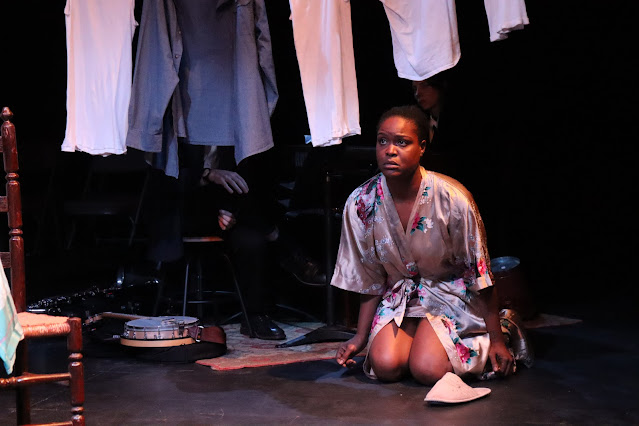Review: Don't Sleep on Snow White-Era Disney Tale "A Venomous Color Part 1: The Fairest"
A Venomous Color Part 1: The Fairest
Written and directed by Cameron Darwin Bossert
Presented by Thirdwing at the wild project
195 E 3rd St., Manhattan, NYC
October 19-24, 2021
 |
| Sivan Gordon-Buxbaum as Frances. Courtesy Karen Greco PR |
The play opens with supervisor and Disney in-law Hazel Sewell (Meghan E. Jones) assuring a reporter of the happiness of the "girls" working under her in what was referred to as The Nunnery, a sex-segrated building in which women inked and painted the work of the company's male animators. The Nunnery is, of course, less idyllic than Sewell's PR-friendly summary suggests. A stifling workspace, mandatory overtime, last-minute aesthetic changes, and the gendered aspect of the artistic hierarchy at Disney are just some of the conditions under which our quartet of protagonists, Helen (Emma DeCorsey), Grace (Sara Ruth Brown), Betty Ann (Taylor Cozort), and Frances (Sivan Gordon-Buxbaum) make their underappreciated contribution to a cinematic milestone. Frances, for better and worse, is the most invested in their work as Art, possessed of a focus that gives her a reputation for speed and musing on the way that the animation makes the Wicked Queen feel like a real person—and this is before she begins holding conversations with something like an amalgam of her self-critical inner voice, the actress whose movements were traced for Snow White's body, and the celluloid Snow White herself (Winnifred Bonjean-Alpart), reproduced, or trapped, depending on one's viewpoint, in millions of copies of hundreds of thousands of individual frames. Her intense relationship with the project nevertheless does not prevent her from being removed at a male animator's request from working on the Wicked Queen.
Intense, intelligent, and lonely, with undefined unhappiness in her past, Frances acts as the play's compelling center in a fantastic turn by Gordon-Buxbaum. The women around her, too, are allowed to develop in rich ways and through rich performances, with initial impressions, for example, of Sewell as an unsympathetic managerial figure leading Bonjean-Alpart's privileged actress Margie on a tour of the facilities and Grace as a beau-preoccupied contrast to art-focused Frances giving way to views of different facets of these complex women. Woven through this character development are broad issues that range from the importance of stories, including, in one passage affectingly delivered by Bonjean-Alpart about (the) film as providing companionship for future lonely or unhappy girls; to the affordance, as Frances puts it, of admiration but not respect for the work of the women inkers and painters; to the perhaps counterintuitive sadness involved in completing a big project.
Frances's repeated invocation, "It's a new time," then, possesses multiple valences. And while A Venomous Color Part 1: The Fairest may not offer a happily ever after, it instead provides a deft mix of humor and psychological drama inflected by its historical specificity, and it keeps surprising the audience right through its striking ending. So take a bite of this enchanting apple before its limited run returns it to the forests of the imagination.
-John R. Ziegler and Leah Richards



Comments
Post a Comment